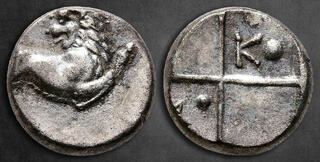| Savoca Numismatik GmbH & Co. KG > Online Auction 198 | Silver | Auction date: 25 February 2024 |
| Lot number: 27 Price realized: 60 EUR (Approx. 65 USD) Note: Prices do not include buyer's fees. | Show similar lots on CoinArchives Find similar lots in upcoming auctions on |
| Lot description: The Thracian Chersonese. Chersonesos circa 386-338 BC. Hemidrachm AR 13 mm, 2,35 g Forepart of a lion right, head reverted / Quadripartite incuse square with alterning raised and sunken quarters; K and pellet in one quarter, pellet and pentagram across in other. Very Fine BMC 38 var. (pentagram without pellet); SNG Ashmolean 3595 var. (K retrograde); HGC 3, 1437. The Thracian Chersonese, a historic peninsula located in the northwest part of present-day Turkey, holds a rich tapestry of ancient tales and significant events. Known for its strategic and cultural importance, this region has witnessed the ebb and flow of civilizations across the centuries. In antiquity, the Thracian Chersonese was primarily inhabited by the Thracians, an ancient Indo-European people. However, its historical prominence heightened during the classical period when the city of Lysimachia was founded by Lysimachus, one of Alexander the Great's Diadochi (successors), in the 4th century BC. One of the pivotal moments etched in the history of the Thracian Chersonese is the legendary city of Troy, located nearby. The Trojan War, chronicled in Homer's "Iliad," unfolded on the plains of Troy, leaving an indelible mark on the region's narrative. During the Peloponnesian War in the 5th century BC, the Athenians established a colony named Sestos on the Chersonese to secure control over the vital Hellespont, a strategic waterway connecting the Aegean Sea to the Sea of Marmara and beyond. The Thracian Chersonese also played a role in the campaigns of Alexander the Great, and later, it became part of the Byzantine Empire. However, its fate continued to shift hands, witnessing the rise of the Ottoman Empire. In the 15th century, the Ottoman Turks, led by Mehmed the Conqueror, captured the Thracian Chersonese, solidifying their dominance in the region. Today, the archaeological remnants and historical sites scattered across the peninsula stand as silent witnesses to the dynamic and diverse history of the Thracian Chersonese. Starting price: 50 EUR |  |


